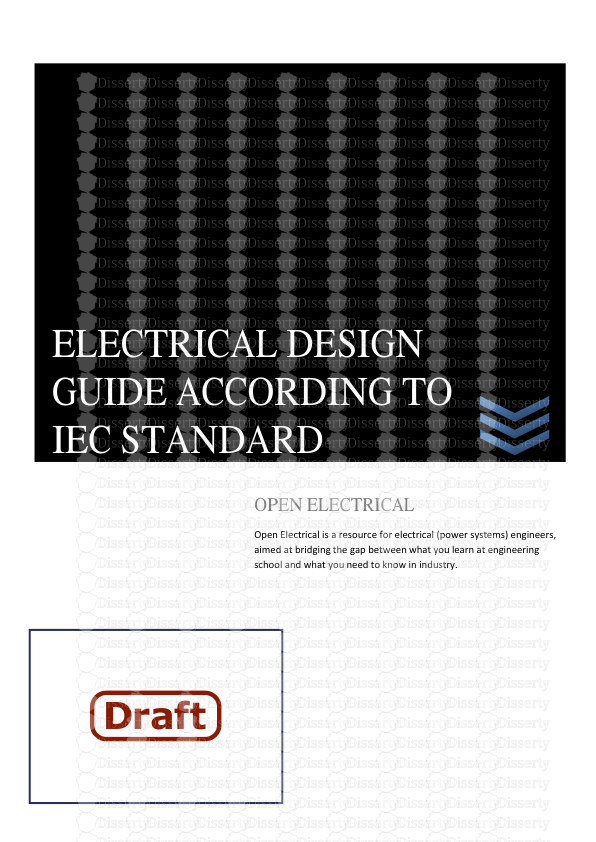OPEN ELECTRICAL Open Electrical is a resource for electrical (power systems) en
OPEN ELECTRICAL Open Electrical is a resource for electrical (power systems) engineers, aimed at bridging the gap between what you learn at engineering school and what you need to know in industry. ELECTRICAL DESIGN GUIDE ACCORDING TO IEC STANDARD Page | 2 Open Electrical is a resource for electrical (power systems) engineers, aimed at bridging the gap between what you learn at engineering school and what you need to know in industry. About Open Electrical Recommended Books Calculations Electrical Load Schedule Energy Load Profile Cable Sizing Calculation Motor Starting Calculation Short Circuit CalculaƟ on (IEC 60909) Earthing CalculaƟ on (IEEE 80) AC UPS Sizing Calculation Battery Sizing Calculation Solar Power System Sizing Calculation Guides Guide to Electrical Cables Guide to Electrical Testing Reference Data Standard IEC Equipment Ratings Low Voltage Cables Low Voltage Motors (IEC) Category: Electropedia A C D E I L N P R S V Page | 3 Open Electrical: About From Open Electrical Open Electrical is a free, independent electrical (power systems) engineering design resource for industry practitioners. It is aimed at bridging the gap between what is taught at engineering school and what is needed to practice effectively in industry. Industry practitioners are normally busy people and when they need information, it's usually for something related to what they are doing right then and there. However, their requirements will depend on how deep or broad they need the information to be. For example, one engineer may need to know something very specific, like what PETP stands for, while another may require something broader, like how to perform a touch and step potential calculation. The philosophy of Open Electrical is to provide all of this information using a layered "onion" approach. The top layer (e.g. the guide to electrical cables) is very broad and provides general information about a topic with links to more specific articles. It's good as a starting point on a topic. But as you peel back the layers, the articles become deeper and more specialized. Page | 4 Recommended Books The following books are those that we recommend as essential to an electrical engineer's library: Network Protection and Automation Guide, Alstom - a classic power systems protection guide that is now freely available online (registration required) Electric Cables Handbook, BICC cables (edited by G. F. Moore) - comprehensive book about cables mainly from a British / European perspective Handbook of Electric Power Calculations, H. W. Beaty - good range of electrical power calculations from the very simple to the more involved. Biased towards North America. High Voltage Engineering & Testing, H. M. Ryan - excellent overivew of high voltage equipment theory and testing techniques (based on an IEE lecture series) Handbook of Photovoltaic Science and Engineering, A. Luque and S. Hegedus - quite possibly the definitive reference book on solar photovoltaic engineering, covering everything from the theory of different PV cells and how they are manufactured, to the engineering design and modelling of PV systems Linden's Handbook of Batteries, T. Reddy - arguably the most comprehensive book on battery technology Electric Machinery, A. E. Fitzgerald et al - clear and detailed exposition of electrical machine fundamentals J&P Transformer Book, M. Heathcote - the most complete book on transformers that was first published in 1925 and has been regularly updated since then Page | 5 Load Schedule Contents 1 Introduction o 1.1 Why do the calculation? o 1.2 When to do the calculation? 2 Calculation Methodology o 2.1 Step 1: Collect list of loads o 2.2 Step 2: Collect electrical load parameters o 2.3 Step 3: Classify the loads 2.3.1 Voltage Level 2.3.2 Load duty 2.3.3 Load criticality o 2.4 Step 4: Calculate consumed load o 2.5 Step 5: Calculate operaƟ ng, peak and design loads 2.5.1 Operating load 2.5.2 Peak load 2.5.3 Design load 3 Worked Example o 3.1 Step 1: Collect list of loads o 3.2 Step 2: Collect electrical load parameters o 3.3 Step 3: Classify the loads o 3.4 Step 4: Calculate consumed load o 3.5 Step 5: Calculate operaƟ ng, peak and design loads 4 Operating Scenarios 5 Computer Software 6 What Next? Page | 6 Introduction Example of an electrical load schedule The electrical load schedule is an estimate of the instantaneous electrical loads operating in a facility, in terms of active, reactive and apparent power (measured in kW, kVAR and kVA respectively). The load schedule is usually categorized by switchboard or occasionally by sub-facility / area. Why do the calculation? Preparing the load schedule is one of the earliest tasks that needs to be done as it is essentially a pre-requisite for some of the key electrical design activities (such as equipment sizing and power system studies). When to do the calculation? The electrical load schedule can typically be started with a preliminary key single line diagram (or at least an idea of the main voltage levels in the system) and any preliminary details of process / building / facility loads. It is recommended that the load schedule is started as soon as practically possible. Calculation Methodology There are no standards governing load schedules and therefore this calculation is based on generally accepted industry practice. The following methodology assumes that the load schedule is being created for the first time and is also biased towards industrial plants. The basic steps for creating a load schedule are: Step 1: Collect a list of the expected electrical loads in the facility Step 2: For each load, collect the electrical parameters, e.g. nominal / absorbed ratings, power factor, efficiency, etc Step 3: Classify each of the loads in terms of switchboard locaƟ on, load duty and load criƟ cality Step 4: For each load, calculate the expected consumed load Step 5: For each switchboard and the overall system, calculate operating, peak and design load Step 1: Collect list of loads Page | 7 The first step is to gather a list of all the electrical loads that will be supplied by the power system affected by the load schedule. There are generally two types of loads that need to be collected: Process loads - are the loads that are directly relevant to the facility. In factories and industrial plants, process loads are the motors, heaters, compressors, conveyors, etc that form the main business of the plant. Process loads can normally be found on either Mechanical Equipment Lists or Process and Instrumentation Diagrams (P&ID's). Non-process loads - are the auxiliary loads that are necessary to run the facility, e.g. lighting, HVAC, utility systems (power and water), DCS/PLC control systems, fire safety systems, etc. These loads are usually taken from a number of sources, for example HVAC engineers, instruments, telecoms and control systems engineers, safety engineers, etc. Some loads such as lighting, UPS, power generation auxiliaries, etc need to be estimated by the electrical engineer. Step 2: Collect electrical load parameters A number of electrical load parameters are necessary to construct the load schedule: Rated power is the full load or nameplate rating of the load and represents the maximum continuous power output of the load. For motor loads, the rated power corresponds to the standard motor size (e.g. 11kW, 37kW, 75kW, etc). For load items that contain sub-loads (e.g. distribution boards, package equipment, etc), the rated power is typically the maximum power output of the item (i.e. with all its sub- loads in service). Absorbed power is the expected power that will be drawn by the load. Most loads will not operate at its rated capacity, but at a lower point. For example, absorbed motor loads are based on the mechanical power input to the shaft of the driven equipment at its duty point. The motor is typically sized so that the rated capacity of the motor exceeds the expected absorbed load by some conservative design margin. Where information regarding the absorbed loads is not available, then a load factor of between 0.8 and 0.9 is normally applied. Power factor of the load is necessary to determine the reactive components of the load schedule. Normally the load power factor at full load is used, but the power factor at the duty point can also be used for increased accuracy. Where power factors are not readily available, then estimates can be used (typically 0.85 for motor loads >7.5kW, 1.0 for heater loads and 0.8 for all other loads). Efficiency accounts for the losses incurred when converting electrical energy to mechanical energy (or whatever type of energy the load outputs). Some of the electrical power drawn by the load is lost, usually in the form of heat to the ambient environment. Where information regarding efficiencies is not available, then esƟ uploads/s3/ electrical-design-guide.pdf
Documents similaires










-
66
-
0
-
0
Licence et utilisation
Gratuit pour un usage personnel Attribution requise- Détails
- Publié le Sep 25, 2022
- Catégorie Creative Arts / Ar...
- Langue French
- Taille du fichier 7.2238MB


